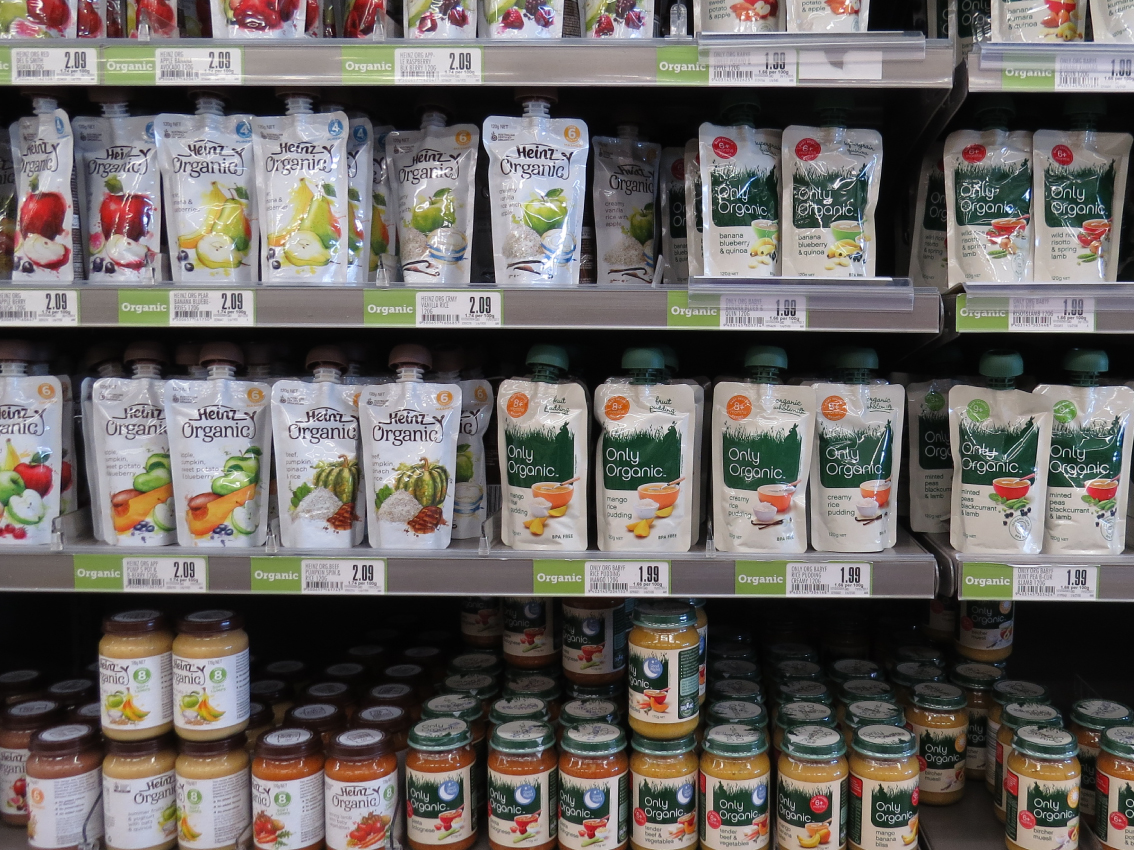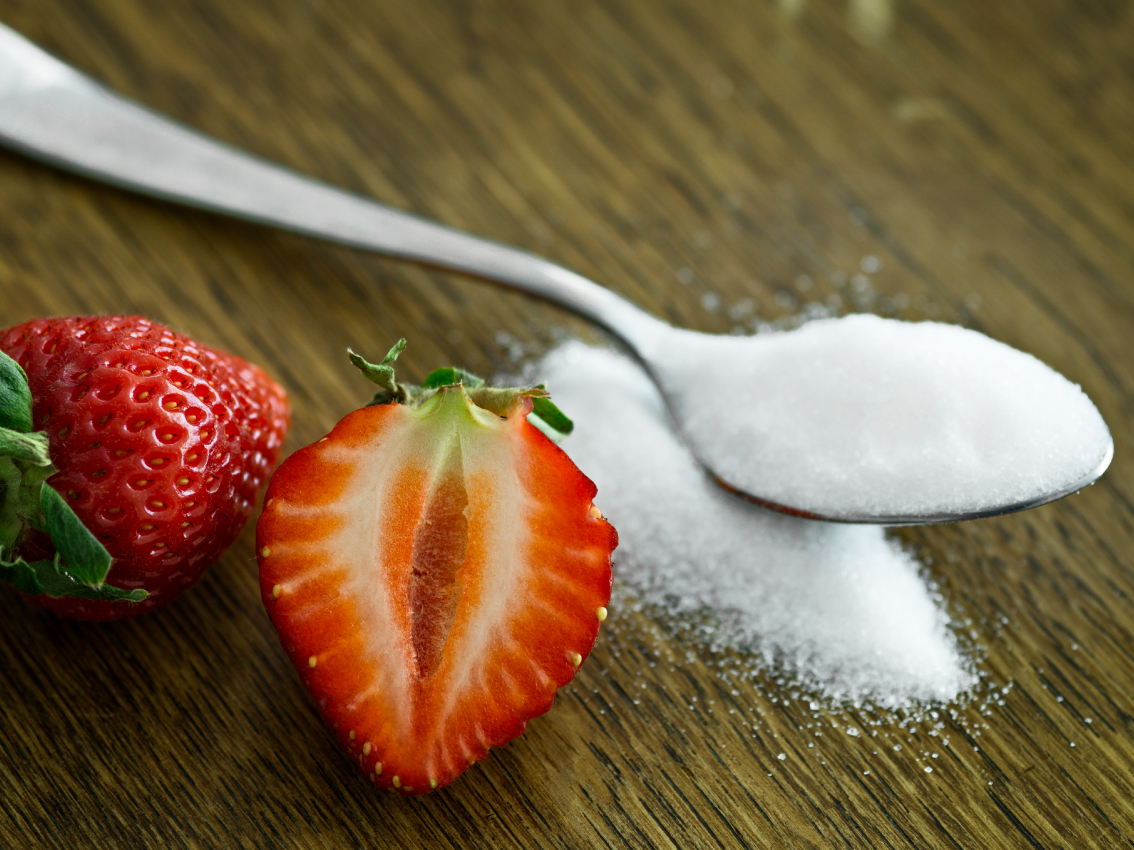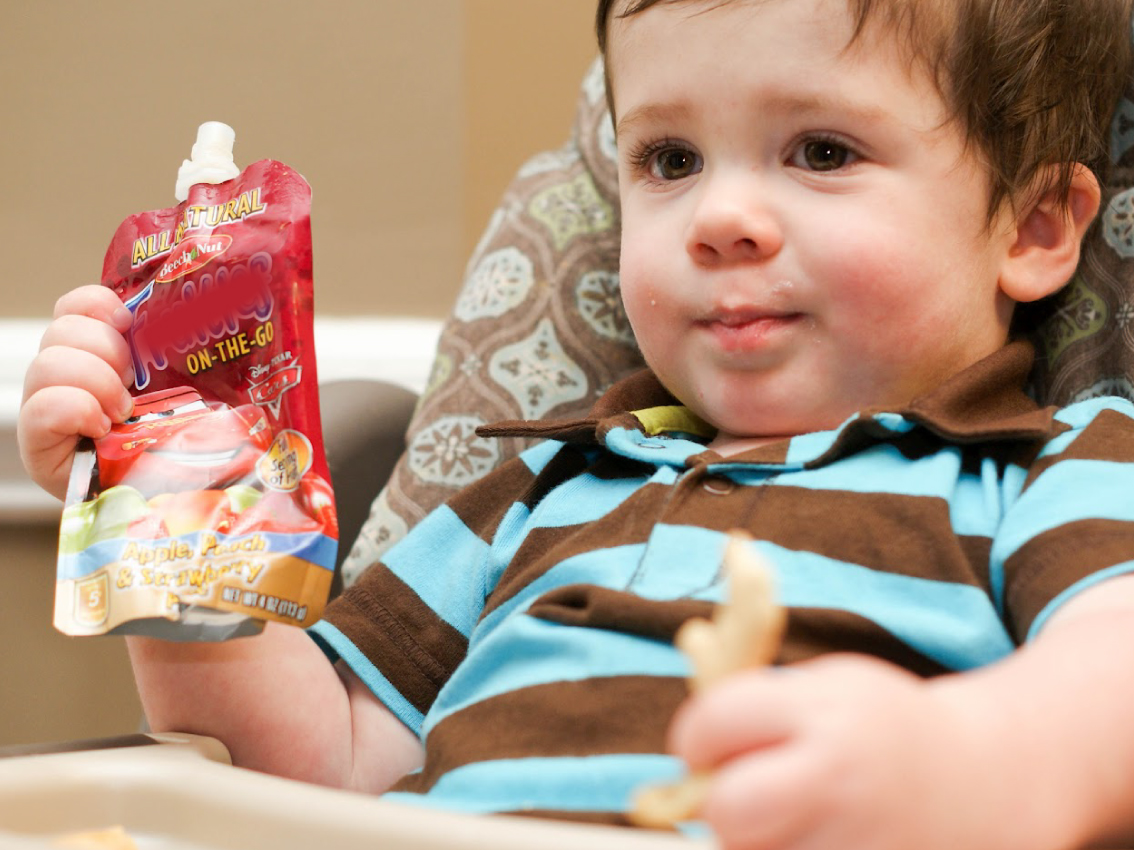Is commercial baby food healthy?

Let’s face it – we live in a fast paced world with a society that has come to look for the easy way to do things, and why not take the easy road. It’s easier right, and ‘keeping it simple’ is often healthy, right? In some cases, yes. But when we are talking about commercial baby food, one must consider the burgeoning gap between what is easy and what is healthy.
Now this blog isn’t saying you shouldn’t use commercial baby food. I am all for parent choice paired with informed choice, and this article is about that. My aim is to give you the tools to know what you are buying and choose the healthier options for your child. However, if you asked me if I think infants should have manufactured baby foods as a consistent form of nutrition? No I do not, and below are some of the reasons why.
Age appropriate
Many of the baby foods in jars and pouches are marketed to infants below the age of six months, despite the World Health Organisation guidelines stating, ‘Infants should start receiving complimentary foods at 6 months of age in addition to breast milk, initially 2-3 times a day between 6-8 months, increasing to 3-4 times daily between 9-11 months and 12-24 months with additional nutritious snacks offered 1-2 times per day, as desired.’ No mention of offering solid foods, or commercial baby food before six months and if you attend one of my ‘Simplify Solids – Plain + Slow = Gain + Grow’ Workshops as I tour New Zealand, you will learn why these guidelines are appropriate when working alongside your infants natural digestive development.

Ingredients and manufacture
There is much to be aware of when looking at the ingredients, and how baby food is manufactured when it comes to weighing up the effect that this may have on your infants overall health and behaviour. So let’s take a look at some of the main contenders that could lead to unsettled days and nights, and possibly ill health later on in life.
Carbohydrates and sugar
As research shows us, the first 1,000 days of life are crucial for brain development. Sugar plays a vital role in this according to Nathan Wallis, a renowned neuroscience educator in New Zealand. He says that, “sugar reduces plasticity.”1 A study published in the National Center for Biotechnology Information website also reports that ‘refined sugar can influence crucial aspects of neuronal and behavioural plasticity associated with the function of the Brain-derived neurotrophic factor (BDNF).2 The BDNF gene provides instructions for making a protein found in the brain and spinal cord called brain-derived neurotrophic factor. This protein promotes the survival of nerve cells (neurons) by playing a role in the growth, maturation (differentiation), and maintenance of these cells.”3 All important at any time of life but absolutely essential in those first 1,000 days of life.
How much sugar your infant consumes also has a profound effect on their sleep, their bodily movement (leads to increased movement with their limbs), bowel motions, gas and their mood – just as it does for adults. A New Zealand group of researchers and public health doctors from the FIZZ organisation state in a letter to the New Zealand Medical Journal that, the amount of sugar appropriate for a six-month-old is “less than two teaspoons per day.”
Dr Gerhard Sundborn, a member of the FIZZ team said in an article published on the Stuff News website that “Children exposed to a high sugar diet at 4 months old – it’s setting their palate up for sweetness, it’s conditioning their palate at a very young age.’ He said, ‘it is most concerning that Plunket, the leading national child health service, endorse a range of high sugar Heinz-Watties fruit purees.’5

So bearing in mind that less than two teaspoons (3-5%) is recommend, FIZZ did a recent study on 33 single-serve Heinz Watties baby foods stocked at an Auckland supermarket. 22 had more than two teaspoons of sugar in them. Of those, 11 contained two to three teaspoons of sugar, 10 contained between three to four teaspoons and one contained four teaspoons. Bad enough as a single serve, now imagine that all your infant eats is commercial baby food. That’s a hang of a lot of sugar in a day for their little bodies!
One other aspect to be aware of when it comes to sugar in baby food is that manufacturers often use sweet fruit and vegetable in dishes that actually appear to be savoury and sometimes these are at higher percentages than the ‘healthy vegetable’ listed in the name of the product. Organic baby food commonly uses lemon juice to sweeten. Also the sugar content in commercial baby food can be much higher than what is on the label because when manufactured they highly macerate and heat treat the product.
Water
According to the First Steps Nutrition Trust “The water content of baby foods is not made explicit on all labels. The water content of many commercial baby foods is greater than is likely to be present in home-made food, and this means that the energy density of the food is likely to be lower. A baby therefore needs to eat a high volume of most commercial baby food to obtain the energy and nutrients found in a smaller portion of home-made food.” They go on to say that “Despite some manufacturers’ claims that meals are ‘nutritionally balanced’, how they calculate this, or what it relates to, is unknown.”4
Sodium
When I studied Infant Nutrition from Breastfeeding to First Solids with Deakin University, I learnt that sodium is often referred to as salt, but it is actually a component of salt. Therefore the sodium can be lower than the actual salt content and with many commercial baby foods only stipulating the sodium content – which may sit within required amounts – one can’t be sure if the salt ratio is healthy. So what is a healthy ratio…
- From newborn to twelve months - 0.4g a day, less than 1g of salt a day
- From one to three year olds - 0.8g a day, less than 2g of salt a day
Dr Carley Grimes, a research fellow at Deakin University, outlines a Deakin University study that shows in Australia the intake of sodium levels for nine month old Australians is “double the amount of intake needed for good health.”6
Too much sodium creates high blood pressure, coronary heart disease, an increase in calcium loss and is also linked to gastric cancer and asthma. As an aside, the World Health Organisation says that high blood pressure accounts for 51% of deaths from stroke and 45% of deaths from narrowing or blocked arteries. They estimate that a reduction of sodium intake of 2.9g a day worldwide would lead to a 22% reduction in deaths from strokes and heart disease.7 So do please be aware of how much sodium is in your infants brought baby food. You can protect their health so much by doing so.
Thickeners
It is common for manufactured foods to have some form of thickener in them these days and on the most part, these are fine for an adult’s digestive system, but this is not the case for the developing infant. The everyday thickeners used in commercial baby food (inclusive of organic) like corn starch, cornflour, ground rice, rice flour, rice starch, tapioca starch, wheat flour, oat flour, amaranth flour, and semolina are not a healthy ingredients for the early developing digestive system. At six months the pancreas is only just beginning to make more enzymes to enable the breakdown of starch and it takes two years before the pancreas can supply this at adult levels.8 Therefore, when an infant eats commercial baby food, there is a high chance they are not absorbing the thickeners well and this could contribute to unsettled behaviour as the digestive system struggles. And yes, this does mean commercial baby rice is not a healthy food to start an infant on, and you can learn more about this here.
Salicylates
Salicylates are naturally found in fruit and vegetables and for most people these are safe to consume, according to a study by Professor I S Young, Wellcome Research Laboratories, Belfast.9 Some however can be sensitive to salicylates and each person/infant can have varying degrees of sensitivity. This is important to take note of when feeding your child commercial baby food because they are typically high in salicylates, being largely fruit and vegetable based, which could also be said for homemade purees. However, the salicylates tend to be increased with commercial baby food because the industry doesn’t peel these during the manufacturing process and salicylates are largely found on the skin of fruit.
Symptoms of salicylates symptoms include10 stuffy nose, sinus infection and inflammation, nasal and sinus polyps, asthma, diarrhoea, gas, abdominal pain, gut inflammation (colitis), hives and tissue swelling.
Pouches
We have all seen them. Perhaps you have used them. Pouches are certainly flooding the market so what are some of the aspects one needs to be aware of...
- Pouches are typically more expensive than buying the right vegetables for your infants age, bulk cooking and freezing in ice cube trays.
- There is a risk that the child will eat directly from the pouch, which so many do. This can have food bi-passing taste buds because of the suck action instead of chewing or mulling the food around in the mouth in preparation for chewing.

- Sucking verses chewing and mulling of food may make children lazy.
- Children, parents, care givers do not see what their child is eating or get a good guide of how much.
- Pouches are not recyclable and let’s face it, even if they were our recycling system is overburdened with the amount it is already trying to cope with.
In summary
Always read the label of the commercial baby food you are buying and take note that organic doesn’t necessarily mean healthy, as they too have many of the factors above happening. The healthiest way to start and continue the wonderful months and years of food exploration is to keep it simple, and make homemade food. It really isn’t that difficult and as long as you are organised, perhaps having bulk cooking and ice tray freezing sessions, then it truly can be simple.
- http://evolutionandimagination.blogspot.com/2015/05/nathan-mikaere-wallis-brain-development.html
- Department of Physiological Science, University of California at Los Angeles, 621 Charles E. Young Drive, 90095, USA.
- https://ghr.nlm.nih.gov/gene/BDNF
- http://www.firststepsnutrition.org/
- https://www.stuff.co.nz/national/health/93718372/Kiwi-babies-being-weaned-on-to-high-sugar-diets-from-4-months-old-health-group-says?rm=m
- http://www.deakin.edu.au/about-deakin/media-releases/articles/everyday-foods-pushing-the-salt-intake-of-toddlers-to-excessive-levels
- https://www.nzherald.co.nz/nz/news/article.cfm?c_id=1&objectid=10643438
- Peter R. Durie, M.D., FRCPC, Professor, Department of Paediatrics, University of Toronto, Division of Gastroenterology/Nutrition Head, CF Research Group, The Research Institute, The Hospital for Sick Children, https://www.pancreasfoundation.org
- L G Hare, J V Woodside and I S Young, J Clin Pathol, v.56(9); 2003 Sep, 649–650. https://www.ncbi.nlm.nih.gov/pmc/articles/PMC1770049/
- Hanns-Wolf Baenkler; Prof Dr med. Dtsch Arzteble Int. 2008 Feb; 105(8): 137-142; Salicylate Intolerance https://www.ncbi.nlm.nih.gov/pmc/articles/PMC2696737/



